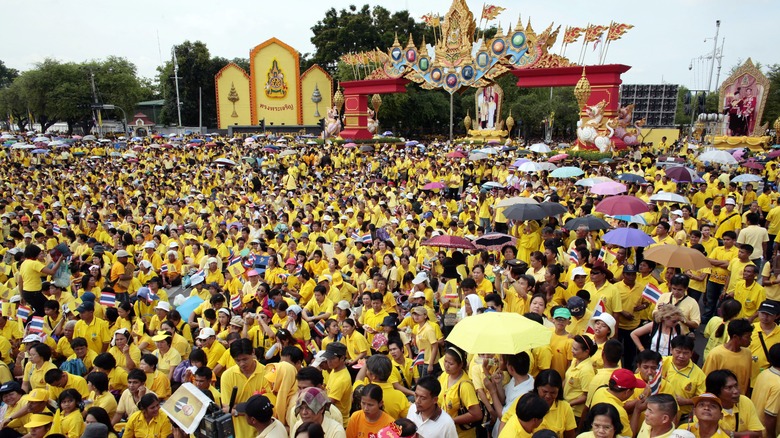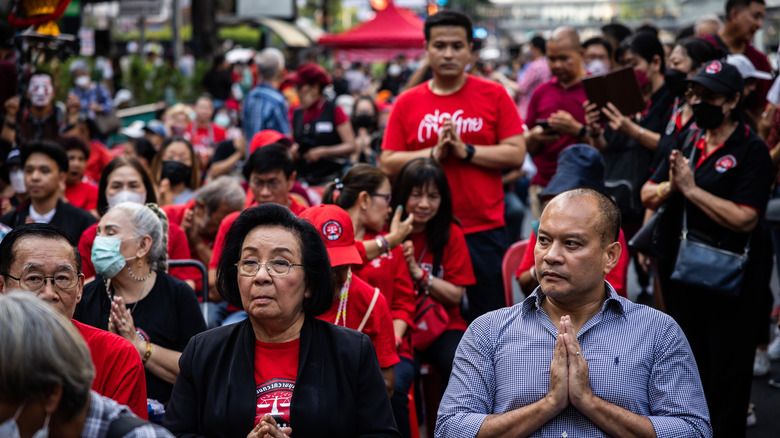From Buddhist values and reverence for the monarchy (with some of the strictest lèse-majesté laws in the world!) to the spiritual beliefs of Sak Yant tattoos and Muay Thai fighting rituals — beyond the inviting charm of the wai greeting, Thailand is a country that holds deep respect for ancient traditions. One of these is a unique clothing color custom that many non-Thai people may be unaware of. For anyone planning a trip to Thailand, understanding this color symbolism can significantly enhance and inform your experience.
What’s in a color? A lot! In Thai culture, colors are more than just visual elements; they carry deep meanings and are associated with specific days of the week, influenced by animistic beliefs and pre-Buddhist Hindu legends. This tradition is based on the idea that colors represent different deities who protect each day of the week. Wearing the appropriate color on the right day will mean good luck for the wearer and affect their physical or mental state — wearing the wrong color, on the other hand, will bring bad luck.
Although this tradition is not particularly popular among young Thai people, the older, more traditional generation follows this custom diligently. On certain days, you may find local Thais wearing the same colors, usually in the form of a T-shirt or polo, and sometimes an entire uniformly colored outfit. Understanding the colors will help you show respect for Thai customs, participate more mindfully in the culture, and certainly help you impress a local.
Colors and their meanings in Thailand

Traditionally worn on Mondays, yellow is associated with His Majesty King Bhumibol Adulyadej, the beloved late King of Thailand, who was born on a Monday, as well as his son and the current King of Thailand, King Maha Vajiralongkorn. Yellow represents the Moon and is a symbol of loyalty to the monarchy. For Tuesdays, pink, the color of the planet Mars, gained popularity as a symbol of good health and longevity, especially when King Bhumibol Adulyadej was ill. Thais wore pink to wish him a speedy recovery in 2016. Signifying Friday, the birthday of Her Majesty Queen Mother Sirikit, blue has become a significant color and is a gesture of support, symbolizing love, tranquility, and Venus.
Other days of the week are associated with their respective colors and celestial bodies — green for Wednesday and Mercury, orange for Thursday and Jupiter, purple for Saturday and Saturn, and red for Sunday and the Sun. Records from Thai culture and history describe a mystical origin for the Sun, rooted in Hindu mythology. The belief narrates that Phra Isuan, a deity in Hinduism, performed a celestial act of creation: He captured six lions and transformed them into powder, which was then enveloped in red cloth. To complete the creation, Phra Isuan sprinkled Nam Amarit, or holy water, over the red cloth-wrapped powder, resulting in the Sun. Thus, for good luck and empowerment, some Thais may wear red on Sunday — Tiger Woods, who is half-Thai, wears red shirts on championship days.
Shades of festivals and politics

Thai festivals and ceremonies bring forth more color palettes, each selected for its symbolic value and ability to convey specific sentiments or beliefs. For example, during Songkran (Thai New Year), bright and vibrant colors dominate, reflecting joy and the spirit of rejuvenation. On the other hand, white is one clothing color associated with Buddhism and is often worn for religious ceremonies to symbolize purity and peace. Black is a color that is generally avoided because it is associated with death and has strong superstitions, similar to the West.
However, certain colors have taken on more political meanings, specifically red and yellow. The Yellow Shirts (People’s Alliance for Democracy) and Red Shirts (United Front for Democracy Against Dictatorship) represent deep political divides in Thailand. The Yellow Shirts, mainly urban elites and royalists, advocate for traditional monarchy and the military’s role in politics, famously seizing Bangkok’s airports in 2008 to oppose Thaksin Shinawatra’s influence.
Conversely, the Red Shirts, largely rural and working-class, support Thaksin’s policies and demand democratic reforms — their protests peaked in 2010, leading to violent crackdowns, which resulted in numerous casualties. Although many years have passed since the height of the conflict, visions for what Thailand should be and the “colors” that denote this divide show no signs of fading. As a foreigner, though, there is no need to be concerned about wearing yellow or red in Thailand — no one will assume that you’re part of a political movement.

